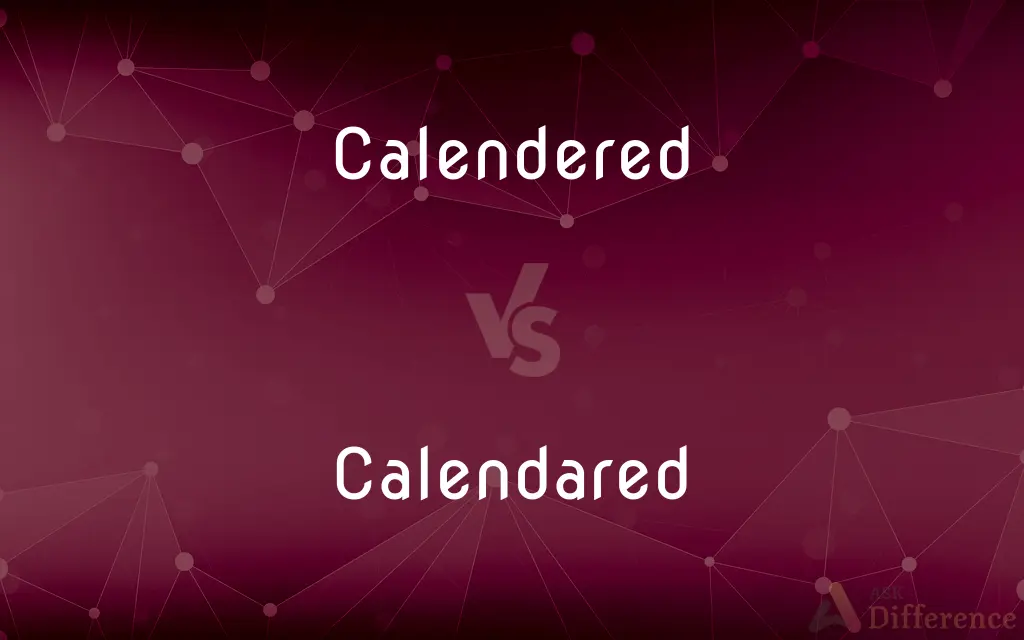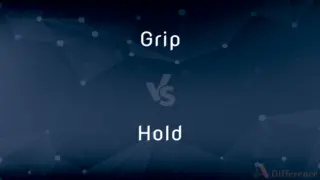Calendered vs. Calendared — What's the Difference?
Edited by Tayyaba Rehman — By Fiza Rafique — Updated on April 7, 2024
Calendered refers to the process of smoothing or finishing fabric through rollers, while calendared describes organizing or scheduling events on a calendar.

Difference Between Calendered and Calendared
Table of Contents
ADVERTISEMENT
Key Differences
Calendered involves passing fabric or paper through rollers to achieve a desired finish, such as smoothness or glossiness, enhancing the material's appearance and texture. On the other hand, calendared pertains to the act of scheduling events, tasks, or reminders by placing them on a calendar, ensuring organization and timely reminders.
The process of calendering fabric can vary, depending on the materials used and the desired effect, such as high gloss or added texture. Whereas calendaring events involves decisions about time management, prioritization, and the logistical organization of personal or professional activities.
Calendered materials are often used in various industries, including fashion and printing, where the finish of the fabric or paper is crucial to the product's appeal and functionality. In contrast, calendared activities span both personal and professional realms, crucial for planning and efficient time use.
Technological advancements have led to sophisticated calendering machines capable of producing a wide range of finishes, tailored to specific industry needs. Conversely, digital calendaring tools have revolutionized how individuals and organizations schedule and share events, offering features like reminders, event sharing, and integration with other digital planning tools.
While calendered is specific to a process applied to materials, the concept of calendared extends beyond mere scheduling; it encompasses strategic planning, ensuring a balanced and organized approach to various commitments and deadlines.
ADVERTISEMENT
Comparison Chart
Definition
Process of finishing fabrics through rollers.
Organizing events or tasks on a calendar.
Primary Use
In fabric and paper industries.
In personal and professional organization.
Desired Outcome
Enhanced material texture and appearance.
Efficient time management and planning.
Tools/Technology
Calendering machines.
Digital calendar applications.
Impact
Affects material properties.
Affects scheduling and planning efficiency.
Compare with Definitions
Calendered
Processed through rollers to smooth or finish.
The calendered fabric displayed a luxurious sheen.
Calendared
Encourages strategic planning.
She calendared her study sessions to prepare systematically for the exam.
Calendered
Involves physical enhancement of materials.
Calendered paper is preferred for high-quality printing.
Calendared
Facilitates time management.
Calendared reminders help him manage his deadlines effectively.
Calendered
Technologically driven process.
Modern calendering machines offer diverse finishes for various materials.
Calendared
Act of scheduling on a calendar.
She calendared our meeting for next Thursday at 10 am.
Calendered
Can vary in effect.
The degree of gloss on calendered items depends on the roller pressure and heat.
Calendared
Utilizes digital tools.
Their team calendared project milestones using an online collaborative tool.
Calendered
Industry-specific application.
The textile industry frequently uses calendered finishes to add value to fabrics.
Calendared
Personal and professional use.
I've calendared both my work appointments and family events for the month.
Calendered
A machine in which paper or cloth is made smooth and glossy by being pressed through rollers.
Calendared
Any of various systems of reckoning time in which the beginning, length, and divisions of a year are defined, sometimes along with multiyear cycles.
Calendered
To press (paper or cloth) in the rollers of such a machine.
Calendared
A table showing the months, weeks, and days in at least one specific year.
Calendered
Simple past tense and past participle of calender
Calendared
A schedule of events.
Calendered
(of paper and fabric and leather) having a surface made smooth and glossy especially by pressing between rollers;
Calendered paper
A dress of glossy sateen
Calendared
An ordered list of matters to be considered:the bills on a legislative calendar.
Calendared
Chiefly British A catalog of a university.
Calendared
To enter in a calendar; schedule.
Calendared
Simple past tense and past participle of calendar
Common Curiosities
Can digital events be calendared?
Yes, digital events, like webinars or virtual meetings, can be scheduled and managed using calendaring tools.
What is the purpose of calendering fabric?
To improve the fabric's appearance and texture, often making it smoother, glossier, or imparting a specific finish.
Can calendered fabric be used for all clothing?
While calendered fabric is used in fashion, its suitability depends on the desired garment look and feel; some applications may prefer non-calendered textures.
What are the benefits of calendering paper?
Benefits include improved smoothness and a glossy finish, enhancing the paper's quality for printing and writing.
Can personal events be calendared alongside professional ones?
Yes, modern calendaring tools allow for the scheduling of both personal and professional events in one system.
Can calendering be reversed?
Once material has been calendered, reversing the process is challenging without affecting the material's integrity.
How does calendering assist in time management?
By organizing tasks and appointments on a calendar, it helps individuals allocate their time efficiently and remember important dates.
What's the difference between manual and digital calendaring?
Manual calendaring involves physical calendars for scheduling, while digital calendaring uses software applications for more flexibility and features.
How does calendering affect paper quality?
It enhances the paper's smoothness and gloss, making it suitable for high-quality printing applications.
Are there specific tools for calendaring events?
Various digital tools and apps are designed for calendaring, offering features for scheduling, reminders, and sharing.
What industries use calendered materials?
The textile and paper industries primarily use calendered materials for products where texture and finish are important.
How does calendering contribute to product quality?
By enhancing material properties like smoothness and gloss, calendering contributes to the aesthetic and functional quality of products.
How has technology impacted calendering in the textile industry?
Technological advancements have allowed for more precise control over the calendering process, enabling a wider range of finishes and enhancing material quality.
How do digital calendaring tools enhance scheduling?
They offer features like automatic reminders, event sharing, and integration with other planning tools, improving scheduling efficiency.
Is calendering a chemical or physical process?
It's primarily a physical process involving the application of pressure and sometimes heat to materials.
Share Your Discovery

Previous Comparison
Grip vs. Hold
Next Comparison
Inherit vs. HeritAuthor Spotlight
Written by
Fiza RafiqueFiza Rafique is a skilled content writer at AskDifference.com, where she meticulously refines and enhances written pieces. Drawing from her vast editorial expertise, Fiza ensures clarity, accuracy, and precision in every article. Passionate about language, she continually seeks to elevate the quality of content for readers worldwide.
Edited by
Tayyaba RehmanTayyaba Rehman is a distinguished writer, currently serving as a primary contributor to askdifference.com. As a researcher in semantics and etymology, Tayyaba's passion for the complexity of languages and their distinctions has found a perfect home on the platform. Tayyaba delves into the intricacies of language, distinguishing between commonly confused words and phrases, thereby providing clarity for readers worldwide.
















































